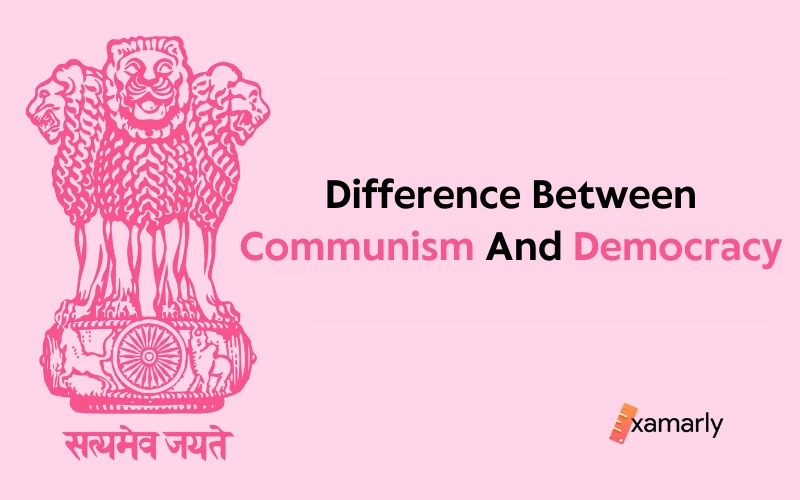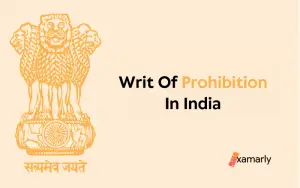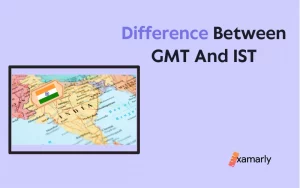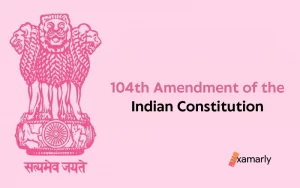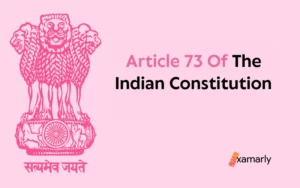Do you want to know the difference between communism and democracy with the key aspects? The ideologies of communism and democracy have had a profound impact on shaping the world, however, they are fundamentally distinct.
While communism is characterized by a lack of economic and political freedom, democracy is defined by the presence of these freedoms.
The fundamental difference between communism and democracy is that in a communist society, the means of production are owned and controlled by the state, whereas in a democratic society, these means are owned and controlled by private individuals.
These differing ideologies have led to vastly different societies and governments throughout history, and have been the cause of much debate and conflict. Understanding the key differences between communism and democracy is crucial for understanding the political landscape of the world. In this blog, let us look into the important aspects of these two ideologies.
- What Is Communism?
- The Important Features Of Communism
- Social Structure Of Communism
- History Of Communism
- Types Of Communism
- Communism As An Ideology
- Important Examples Of Communism
- Government Form In Communism
- What Is Democracy?
- The Important Features Of Democracy
- Social Structure Of Democracy
- History Of Democracy
- Types Of Democracy
- Democracy As An Political Ideology
- Communism Vs Democracy – A Comparison
- Summing Up
- Frequently Asked Questions
What Is Communism?
Communism is a political and economic doctrine that aspires to abolish private property and a profit-oriented economy and replace them with collective ownership and control of the key means of production, such as factories, mines, and resources by the state or the community. It aims for a classless society where resources and wealth are distributed equally among all citizens.
The theory of communism was initially developed by Karl Marx and Friedrich Engels in the mid-19th century and has been implemented in various forms in different countries.
It is considered by its advocates as a higher and more advanced form of socialism. The distinction between communism and socialism is a long-debated topic, with the main difference being the communists’ adherence to revolutionary socialism as espoused by Karl Marx.
The Important Features Of Communism
The key features of communism include:
- Common ownership and control of the means of production: In a communist society, the state or the community owns and controls property, resources, and the means of production.
- Abolition of private property: Private property is abolished under communism, and all resources are distributed among the people according to their needs.
- Classless society: The goal of communism is to create a classless society where everyone has equal access to resources and wealth.
- Centralized government control: The government plays a central role in planning and directing the economy in a communist society.
- Elimination of market economy: In a communist society, there is no market economy, and the government controls the distribution of goods and services.
- Elimination of money: In a communist society, money is abolished and replaced with a system of direct allocation of goods and services.
- Emphasis on equality and social justice: The ultimate goal of communism is to create a society where everyone is treated equally and social justice is achieved.
It is important to note that the implemented version of communism, especially in the 20th century, was very different from the theory, and was criticized for lack of human rights, political repression, and economic inefficiency.
Related Article : Difference Between Communism And Communalism
Social Structure Of Communism
In a communist society, the goal is to eliminate class distinctions, meaning that there would be no more distinctions between the rich and the poor, the owners and the workers, or the ruling class and the working class.
The idea is that everyone would be both the owners of the means of production and their employees, which means that everyone would have an equal stake in society and its economy.
The means of production, such as factories, mines, and resources, would be collectively owned and controlled by the state or the community, rather than by private individuals, this would eliminate the ruling class from taking advantage of the working class.
This concept aims for a society where everyone has equal access to resources and wealth, and social justice is achieved.
History Of Communism
Communism is a social and economic belief system that aims for a society without classes and a state, where the means of production are held and managed by the community collectively.
The ideology has its roots in the theories of Karl Marx and Friedrich Engels, who outlined the principles of communism in their 1848 publication “The Communist Manifesto.” Karl Marx is also known as the father of communism.
The first communist state was established in 1917 with the Bolshevik Revolution in Russia, led by Vladimir Lenin. The Soviet Union became the first country to officially adopt communism as its state ideology. Other countries, such as China, Vietnam, Cuba, and Eastern European countries, also adopted communist governments in the 20th century.
The implementation of communist political parties varied widely among these countries, but in general, they sought to establish a planned economy and abolish private ownership of the means of production. Many communist states also implemented policies of collectivization, in which land and other resources were taken from private individuals and placed under state control.
The history of communism is characterized by both successes and failures. Some communist states, such as the Soviet Union, China, and Cuba, were able to industrialize rapidly and make significant progress in areas such as education and healthcare.
However, many communist states also experienced economic stagnation and political repression, leading to widespread poverty and human rights abuses.
The collapse of the Soviet Union in 1991 marked the end of communism as a major political force in the world, and today, there are very few countries that still describe themselves as a communist.
Types Of Communism
- Marxism-Leninism: This type of communism is based on the ideas of Karl Marx and Vladimir Lenin and emphasizes the role of a revolutionary vanguard party in achieving a socialist revolution.
- Maoism: This type of communism is based on the ideas of Chinese leader Mao Zedong and emphasizes the role of rural peasants in achieving a socialist revolution.
- libertarian communism: This type of communism emphasizes individual freedom and democracy, and rejects the idea of a vanguard party.
- market communism: This type of communism proposes to use market mechanisms to allocate goods and services, instead of central planning.
It’s worth noting that the different types of communism vary in terms of their specific beliefs and tactics, and different communist countries have implemented different forms of communism.
Communism As An Ideology
Communism is an ideology that seeks to establish a classless, stateless society in which the means of production are collectively owned and controlled by the working class, to achieve greater social and economic equality.
The ultimate goal of communism is to create a society where resources are distributed according to the needs of each individual, rather than according to one’s ability to pay.
Communism is based on the idea that the current capitalist system, in which a small group of people own and control the means of production and exploit the working class, is inherently unjust and leads to inequality.
It argues that the only way to achieve true equality and fairness is to abolish private ownership of property and the means of production and to have the government or the people collectively own and control these resources.
The ideology also emphasizes the elimination of social classes and the creation of a society in which everyone works according to their abilities and receives according to their needs.
This is to be achieved through the establishment of a planned economy, in which the government controls the economy and makes decisions about production and distribution, rather than allowing the market to determine these outcomes.
Communism, as an ideology, has been implemented in a variety of ways in different countries, and the specific beliefs and tactics have varied. Some forms of communism have been highly authoritarian, while others have emphasized democratic participation and individual freedom.
Read More: Capitalism Vs Socialism Vs Communism
Important Examples Of Communism
There are currently several countries in the world that identify as communist or have a communist government. However, the specific form of communism that is practised in these countries varies widely, and the term “communism” can have different meanings in different contexts.
Some examples of countries that currently have a communist government include:
- Cuba: Cuba has been ruled by the Communist Party of Cuba since 1959, and has a planned economy and a single-party political system.
- China: China has been ruled by the Communist Party of China since 1949, and has a mixed economy with a significant state-owned sector and a single-party political system.
- Vietnam: Vietnam has been ruled by the Communist Party of Vietnam since the end of the Vietnam War in 1975, and has a planned economy and a single-party political system.
- Laos: Laos has been ruled by the Lao People’s Revolutionary Party since 1975, and has a planned economy and a single-party political system.
It’s worth noting that some of these countries have undergone significant economic and political changes in recent years, and the specific policies and practices in place may differ from the traditional understanding of communism.
In addition, some other countries like North Korea, identify themselves as socialist or communist, but their system of governance is highly authoritarian and centralized in a single party, making it hard to classify it as a true communist state.
It’s also worth noting that the term “communism” can also be used to refer to a broader social and political movement that aims to establish a classless, stateless society based on collective ownership and control of the means of production.
While there are no countries currently in existence that have fully implemented this vision of communism, there are still some political movements and groups around the world that identify as communist and are working towards this goal.
Read More: Difference Between Capitalism And Communism
Government Form In Communism
In practice, communist governments have often been characterized by a single-party political system, in which a communist party holds a monopoly on political power and makes decisions on behalf of the people.
This party is usually led by a small group of leaders who hold the highest positions of power in the government.
The economy is usually planned and controlled by the state, with the government making decisions about production and distribution. Private ownership of property and the means of production is abolished, and the state or the people collectively own and control these resources.
Communist governments have also often implemented policies aimed at eliminating social classes and creating a society in which everyone works according to their abilities and receives according to their needs.
This has been achieved through policies such as the collectivization of agriculture, the nationalization of key industries, and the establishment of a central planning authority to make decisions about production and distribution.
It’s worth noting that the specific government systems of communist countries have varied widely in practice, and the results have been mixed.
Some countries have experienced rapid industrialization and improvements in living standards, while others have suffered from economic stagnation and political repression.
What Is Democracy?
Democracy is a form of government where the authority is vested in the people, either directly or through elected representatives. It is characterized by free and fair elections, political freedom, limited government, respect for individual rights, and separation of powers. I
n a representative democracy, citizens elect representatives to make decisions for them, in direct democracy citizens make decisions directly.
Democracy is considered the best system for ensuring freedom, accountability, and the protection of individual rights. However, it is not a perfect system and can have its challenges and imperfections.
The Important Features Of Democracy
- Free and fair elections: In a democracy, the people have the right to vote for their leaders and representatives in regular, free and fair elections.
- Political freedom: In a democracy, citizens have the freedom to express their opinions and participate in political life without fear of repression or persecution.
- Limited government: In a democracy, the powers of the government are limited by a constitution or other legal framework, and the government is accountable to the people.
- Respect for individual rights: In a democracy, the government must respect the basic rights and freedoms of all individuals, such as freedom of speech, religion, and assembly.
- Separation of powers: In a democracy, the power is separated among different branches of government, such as the executive, legislative and judicial branches, to prevent any one branch from becoming too powerful.
Social Structure Of Democracy
The social structure of a democratic society is typically characterized by a high degree of individual freedom and equality, as well as the protection of individual rights and freedoms. In a democratic society, citizens have the right to participate in political life and have a say in the decisions that affect them.
Democracies typically have a pluralistic society, in which a diversity of groups and individuals with different backgrounds, beliefs, and interests coexist and participate in the political process. This allows for a wide range of voices and perspectives to be heard and considered in decision-making.
The social structure of democracy also includes the protection of minority rights and the respect for diversity. In a democratic society, everyone has the right to participate in political life regardless of race, gender, religion, sexual orientation, or other factors.
It’s worth noting that, the social structure of democracy may vary depending on the specific country and its history, culture and context. In some countries, certain groups may face more barriers to participation than others. And there are also some challenges and imperfections that democracies face in terms of ensuring equality and protecting the rights of all citizens.
Related article: Difference Between Socialism and Democracy
History Of Democracy
The word “democracy” is derived from the Greek words “demos” meaning people and “Kratos” meaning power. It was first used to describe the system of government in Athens, Greece in the 5th century BCE.
This system, known as Athenian democracy, was a direct democracy in which all male citizens were eligible to participate in the assembly, where they would debate and vote on laws and policies.
While Athenian democracy was limited in scope and excluded many groups, such as women and slaves, it is considered to be the first known instance of direct democracy.
The concept of democracy was later further developed and expanded by philosophers such as Aristotle and thinkers of the Enlightenment, like John Locke, Jean-Jacques Rousseau, and Thomas Paine.
The term democracy was coined by the ancient Greeks to describe a system of government in which citizens were actively involved in the decision-making process.
Since then, the meaning and scope of democracy have evolved and expanded over time, and today it is generally understood to refer to a form of government in which the authority is vested in the people, either directly or through elected representatives.
Types Of Democracy
- Direct democracy: In a direct democracy, citizens make decisions directly, without the intermediary of elected representatives. This type of democracy is characterized by citizen participation in decision-making and laws are made by citizens themselves.
- Representative democracy: In a representative democracy, citizens elect representatives to make decisions on their behalf. This is the most common form of democracy practised around the world.
- Parliamentary democracy: In a parliamentary democracy, the executive branch of government is accountable to the legislative branch, usually through a Prime Minister who is appointed by the majority party or coalition.
- Presidential democracy: In a presidential democracy, the executive and legislative branches are separate, and the president is elected directly by the people.
- Semi-presidential democracy: In a semi-presidential democracy, there is a separation of powers between the executive and legislative branches, and the president is elected directly by the people and shares power with a prime minister who is appointed by the majority party or coalition
- Constitutional democracy: In a constitutional democracy, the powers of the government are limited by a constitution or other legal framework, and the government is accountable to the people.
- Liberal democracy: In a liberal democracy, individuals have protection for their liberty and property, and the government is elected through representative means, guided by the rule of law.
- Social Democracy: Social democracy is a political ideology that combines elements of socialism and capitalism, with an emphasis on democracy and the welfare of all citizens. It advocates for a mixed economy, where the government regulates and intervenes in markets to promote social and economic equality, while still allowing for private enterprise and competition. It is characterized by policies that aim to support people with low-paying jobs
It’s worth noting that different countries have their unique political systems, and the specific form of democracy that is practised in each country may have its characteristics and variations.
Democracy As An Political Ideology
Democracy as a political ideology is based on the belief in the principle of popular sovereignty, the idea that the legitimate source of political power is the people. It emphasizes the importance of individual freedom and equality, and the protection of individual rights and freedoms.
It also stresses the importance of participation and representation, so that the voices and perspectives of all citizens can be heard and considered in the decision-making process.
Democratic ideology is built on the belief that all citizens are equal and have the right to participate in the political process, and that the government should be accountable to the people and responsive to their needs and preferences.
In a democratic society, the government is limited by a constitution or other legal framework, and the power is separated among different branches of government, such as the executive, legislative, and judicial branches, to prevent any one branch from becoming too powerful.
Democratic ideology also includes the protection of minority rights and respect for diversity. In a democratic society, everyone has the right to participate in political life regardless of race, gender, religion, sexual orientation, or other factors.
Important Examples Of Democracy
Many countries around the world currently have a democratic form of government. Some examples include:
- United States: The United States is a federal presidential representative democratic republic, where citizens elect representatives to the federal government and state governments.
- United Kingdom: The United Kingdom is a parliamentary democracy, where citizens elect representatives to the Parliament, and the executive branch of government is accountable to the legislative branch.
- France: France is a semi-presidential democratic republic, where citizens elect a president who shares power with a prime minister who is appointed by the majority party or coalition.
- Canada: Canada is a federal parliamentary democracy, where citizens elect representatives to the Parliament and the executive branch of government is accountable to the legislative branch.
- Australia: Australia is a federal parliamentary constitutional monarchy, where citizens elect representatives to the Parliament and the executive branch of government is accountable to the legislative branch.
- Germany: Germany is a federal parliamentary republic, where citizens elect representatives to the Parliament and the executive branch of government is accountable to the legislative branch.
Government Form In Democracy
The specific structure of a democratic government can vary depending on the country and its specific system of government, but typically includes the following elements:
- A legislative branch: This branch of government is responsible for making laws and representing the people. In a representative democracy, citizens elect representatives to the legislative branch, usually called a parliament or congress.
- An executive branch: This branch of government is responsible for implementing and enforcing laws. In a presidential democracy, the executive branch is headed by a president who is elected directly by the people. In a parliamentary democracy, the executive branch is headed by a prime minister who is appointed by the majority party or coalition in the legislative branch.
- A judicial branch: This branch of government is responsible for interpreting laws and settling disputes. In a democratic government, the judicial branch is independent of the other branches and is responsible for upholding the constitution and protecting individual rights.
- Separation of powers: In a democratic government, the powers of the government are separated among the different branches, to prevent any one branch from becoming too powerful. This is intended to ensure that the government is accountable to the people and that individual rights are protected.
- A constitution or other legal framework: In a democratic government, the powers of the government are limited by a constitution or other legal framework. This is intended to ensure that the government is accountable to the people and that individual rights are protected.
It’s worth noting that different democratic systems may have variations and specific characteristics that define their government structure. However, the main idea behind the government structure in democracy is that the power is held by the people and that the government is accountable to the people, through regular and free elections and other forms of participation.
Communism Vs Democracy – A Comparison
| System | Democracy | Communism |
|---|---|---|
| Origin of Political Power | People | State/working class |
| Individual Rights and Freedoms | Protected | Limited |
| Economic System | Market-oriented | Planned |
| Private Property | Allowed | Abolished |
| Role of Government | Limited | Centralized |
| Political Participation | Voluntary | Obligatory |
| Social Classes | May exist | Elimination as a goal |
| Distribution of wealth and resources | Market-based | Based on need |
| Political opposition | Allowed | Suppressed |
Summing Up
In conclusion, communism and democracy are two distinct forms of government with distinct ideologies. Democracy is a system in which the power is held by the people, either directly or through elected representatives, while communism is a system in which the means of Manufacturing and distribution are controlled and owned by the community or state collectively.
Both systems have their strengths and weaknesses, and both have been implemented in various forms throughout history, with varying levels of success. Ultimately, the choice between communism and democracy will depend on the specific context and the needs of a given society.
Frequently Asked Questions
What are the dissimilarities between communism and democracy?
The main difference between communism and democracy is that in communism, the means of production and distribution are owned and controlled by the state or the community as a whole, while in democracy, the authority is vested in the people, either directly or through elected representatives.
Which system is better, communism or democracy?
Both systems have their strengths and weaknesses and the choice between them will depend on the specific context and the needs of a given society.
Can a country be both communist and democratic?
Some countries have attempted to combine elements of both communism and democracy in their political systems, but the two ideologies are fundamentally different, and it is difficult to reconcile them in practice.
Is communism still practised in any country today?
While there are still countries that consider themselves to be communist, the form of communism that is practised in these countries is often significantly different from the ideology as it was originally proposed.
How does a democracy differ from a dictatorship?
In a dictatorship, power is held by a single individual or a small group, who rule without the consent of the governed. In a democracy, power is held by the people, either directly or through elected representatives.
How does a democracy differ from a monarchy?
In a monarchy, power is held by a single individual or family who inherited the throne, while in a democracy power is held by the people, either directly or through elected representatives.


